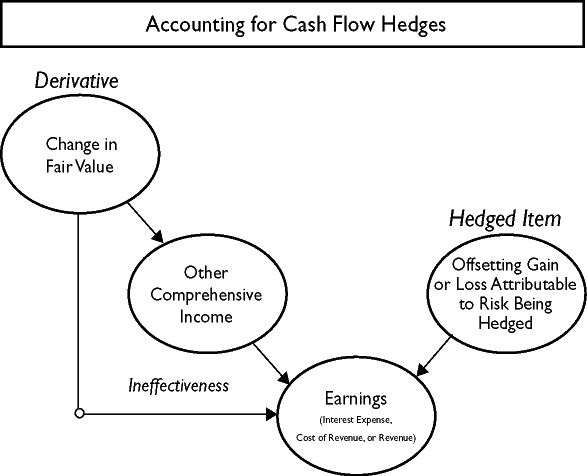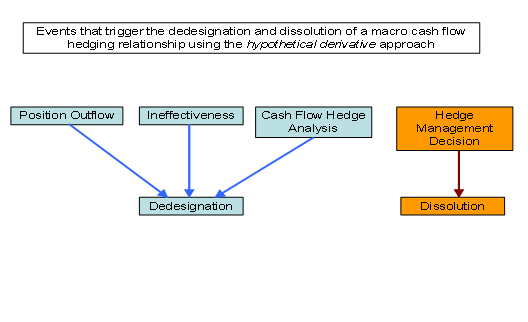Accounting For Cash Flow Hedging
Post on: 16 Май, 2015 No Comment

Cash flow hedging is used by a company [business] to protect themselves against price risk of their forecasted inventory purchases. Cash flow hedges use derivative instruments to hedge the exposure to variability in expected future cash flows. What is accounting for cash flow hedging? I will quickly explain through this post. Enjoy!
Advertisement
Hedging Instruments—General Criteria
Two primary criteria must be met in order for a derivative instrument to qualify as a hedging instrument:
- Sufficient documentation must be provided at the beginning of the process to identify at a minimum (1) the objective and strategy of the hedge, (2) the hedging instrument and the hedged item, and (3) how the effectiveness (see below) of the hedge will be assessed on an ongoing basis.
- The hedge must be “highly effective” throughout its life. Effectiveness is measured by analyzing the hedging instrument’s (the derivative instrument) ability to generate changes in fair value that offset the changes in value of the hedged item. At a minimum, its effectiveness will be measured every three months and whenever earnings or financial statements are reported. A “highly effective” hedge has been interpreted to mean that “the cumulative change in the value of the hedging instrument should be between 80 and 125% of the inverse cumulative changes in the fair value or cash flows of the hedged item.” (This is a reuse of the definition of “high correlation” from SFAS 80. SFAS 133 does not provide any specific definition for “highly effective,” so this definition has been offered as a surrogate).

The method used to assess effectiveness must be used throughout the hedge period and must be consistent with the approach used for managing risk. Similar hedges should usually be assessed for effectiveness in a similar manner unless a different method can be justified. (Even though a hedging instrument may meet the criterion for being highly effective, it may not eliminate variations in reported earnings, because to the extent that a hedging instrument is not 100% effective, the difference in net loss or gain in each period must be reported in current earnings).
Specific Criteria for Cash Flow Hedging
Additional criteria must be met in order to qualify as a cash flow hedge. The primary criterion is that the hedged asset/liability and the hedging instrument must be “linked.” Linking is established if the basis (the specified rate or index) for the change in cash flows is the same for the hedged asset/liability and the hedging instrument.
Cash flows do not have to be identical, but they must meet the highly effective threshold discussed above. In addition, if the hedged asset/liability is a forecasted transaction, it must be considered probable, based on appropriate facts and circumstances (i.e. past history). Also, if the forecasted hedged asset/liability is a series of transactions, they must “share the same risk exposure”. Purchases of a particular product from the same supplier over a period of time would meet this requirement.
Under SFAS 133, for the hedging instrument (1) the effective portion is reported in other comprehensive income, and (2) the ineffective portion and/or excluded components are reported on a cumulative basis to reflect the lesser of (1) the cumulative gain/loss on the derivative since the creation of the hedge, or (2) the cumulative gain/loss from the change in expected cash flows from the hedged instrument since the creation of the hedge. These amounts need to be adjusted to reflect any reclassification of other comprehensive income to current earnings. This will occur when the hedged asset/liability affects earnings (e.g. when hedged inventory is sold and the cost of inventory passes through to cost of goods sold).
Cash Flow Hedging Case Example
A commercial bakery believes that wheat prices may increase over the next few months. To protect itself against this risk, the bakery purchases call options on wheat futures to hedge the price risk of their forecasted inventory purchases. If wheat prices increase, the profit on the purchased call options will offset the higher price the bakery must pay for the wheat. If wheat prices decline, the bakery will lose the premium it paid for the call options, but can then buy the wheat at the lower price. On June 1, 2009, the bakery pays a premium of $350 to purchase a September 30, 2009 call for 1,000 bushels of wheat at the futures price of $16.60 per bushel. The call option is considered a cash flow hedge because the designated risk that is being hedged is the risk of changes in the cash flows relating to changes in the purchase price of the wheat. On September 30, the bakery settles its call options and purchases wheat on the open market. Pertinent wheat prices are shown below.














